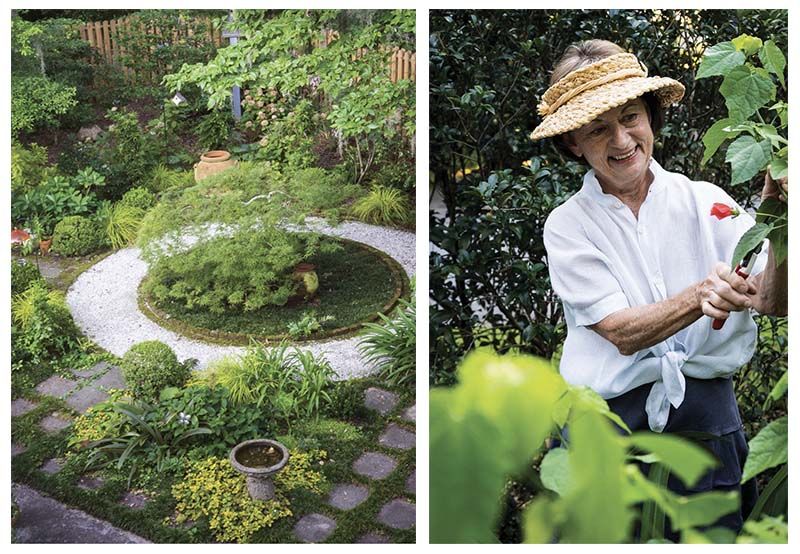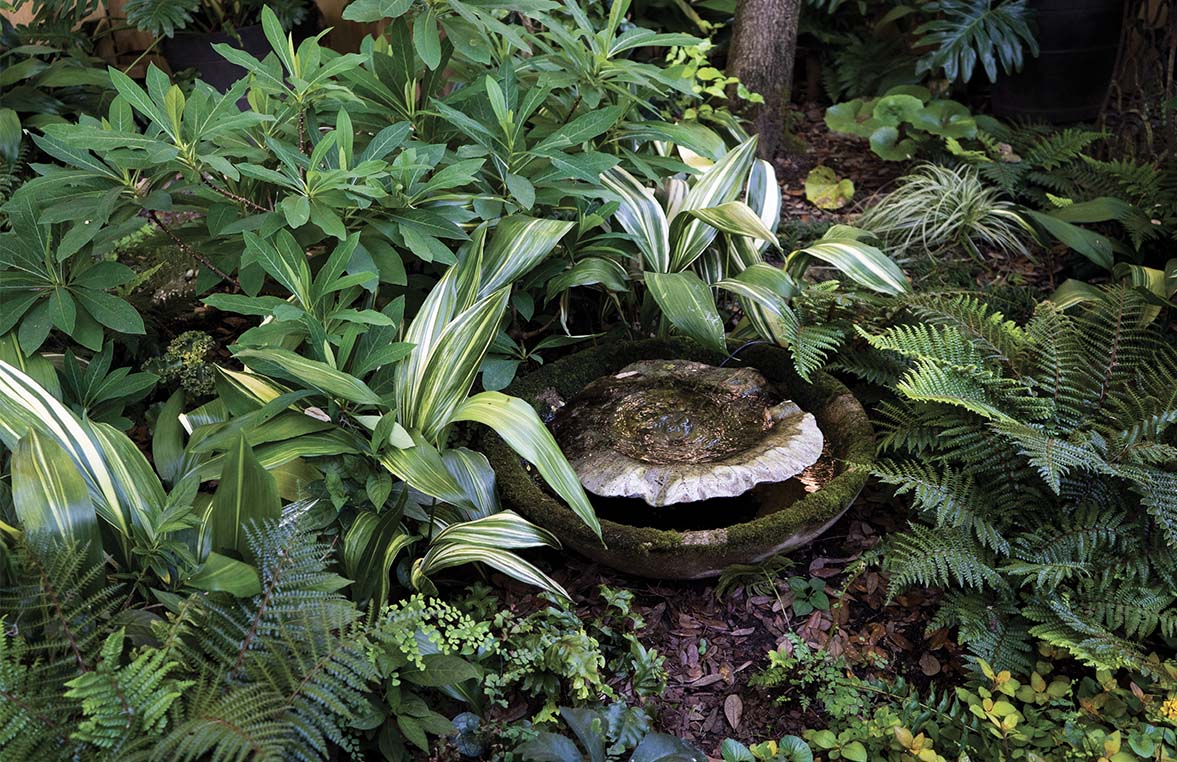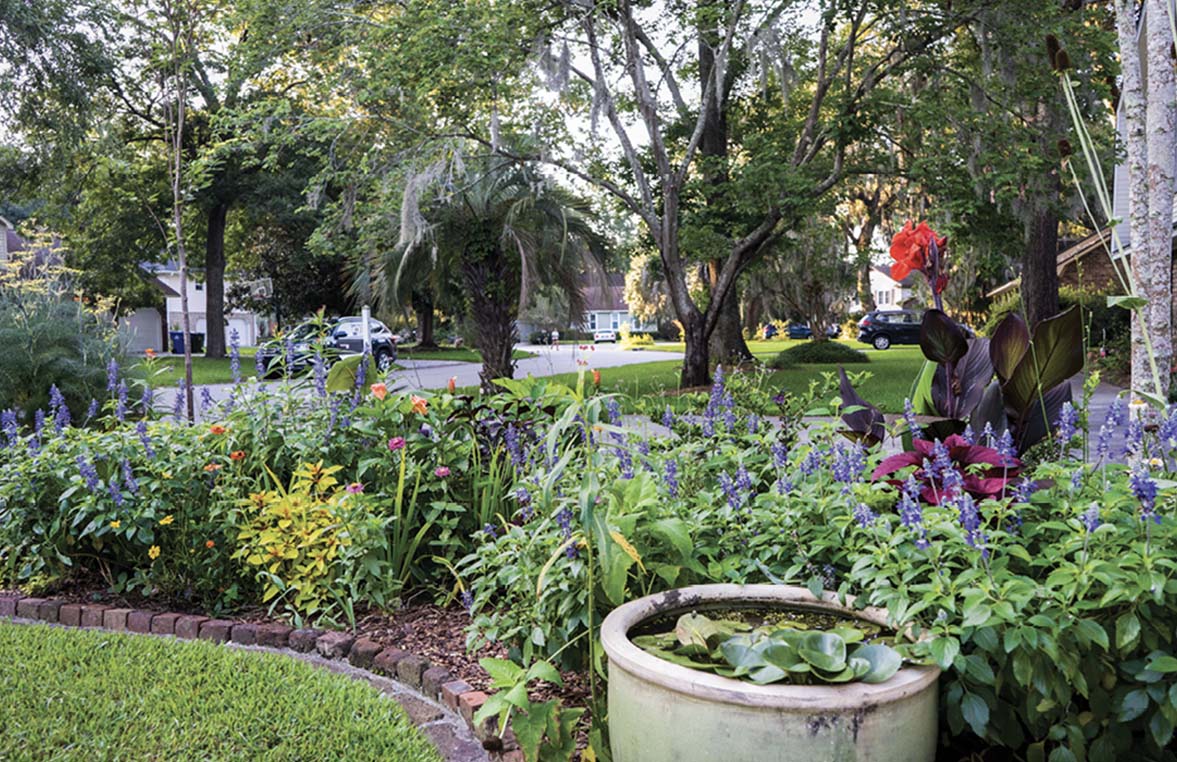Garden designer Beverly Rivers shares her passion project

The leathery leaves of a variegated cast iron plant—each streaked uniquely in cream—arch over a tassel fern, whose lustrous foliage is punctuated by a Southern maidenhair’s mosaic-like growth. Stray fronds dip into a low, moss-covered fountain where even the littlest birds, like chickadees, drink.
A lot of life takes place in one square foot of Beverly Rivers’s West Ashley garden: a verdant tapestry designed to nurture the microorganisms below ground and all the buzzing, crawling, singing things above. It took decades of digging to create this rich expanse—which stretches from an oak-shaded backyard to an elevated courtyard in front—but also a “late-life revelation,” laughs Rivers, a garden designer now mostly retired.
Honestly, there was no time for earlier revelations. Rivers’s passion for growing was still new in the mid-1980s, when divorce pushed her to turn it into a business—one that could help support her three sons and herself. Enrolling in Trident Tech horticulture classes, “My vision was to fill Charleston with window boxes,” she says. “At the time, there may have been two downtown.”
As prophetic as that sounds, clients instead put her to work filling their decks, terraces, and courtyards with plant life and keeping it all looking “ready for a party.” Within the decade, she’d added exciting jobs to her roster including growing an exquisite jungle within Charleston Place’s glass-walled courtyard and working with local gardening icon Patti McGee in her Anson Street green space, fêted over the years in countless books, magazines, and TV programs.
Rivers’s own suburban outdoors evolved from a kids’ ballpark into a work zone. She created a “trial garden” along her driveway to test new species. The backyard became storage for interesting and hard-to-find plants bound for other people’s soil. While free moments were rare, “I’d occasionally buy something for myself and plant it after awhile,” she recalls.

Cool & Collected: ”In the long run, texture will give you more satisfaction in the garden than flowers ever will,” says Rivers of her propensity for mingling plants with contrasting forms and leaf shapes. Here, she highlights a moss-frosted fountain with an array that includes edgeworthia—a four-season stunner—variegated cast iron plants, and Southern maidenhair and tassel ferns. “Maidenhair is one of the prettiest ferns to blend with just about anything because it’s so delicate,” says Rivers. “It drops spores that always seem to sprout up in places that surprise and delight. I find myself saying, ’Okay, I didn’t even think about putting you there, but that’s a great spot—I’m glad you found it!‘”
Finally, in the mid-2000s, she hired a brick mason to create “some geometry” behind the house. She prioritized this space because it was shaded by three live oaks, “and I like to be cool and comfortable when I work outside,” she says. Plus, it was the view she looked on every day from her desk in the family room.
At the garden’s center, the mason formed a round bed that showcases a weeping Japanese maple. A path of crushed oyster shell rings it, granting entrance to walkways that radiate into the grounds. To the left, he shaped another large circle: this one a flagstone and brick terrace stretching beneath a dogwood. Near the back fence, square stepping stones interplanted with dwarf mondo grass make a stage for a Tuscan olive jar—a winter focal point. Off to the right, the same materials pave a rectangle that ends at a pedestal bird bath.
Still, another 10 years passed before Rivers began to lighten her workload and at last focus on “intentionally planting things I loved.” Curated through the decades, her list of favorites gives precedence to lovely form and foliage. If a plant also blooms, “I celebrate that,” she says, “but flowers fade. Texture lasts, and I love creating interesting combinations.”
To anchor the landscape, she brought in often-unique varieties of mahonias, camellias, crepe myrtles, tea olives, and anise shrubs. Edgeworthia, or Chinese paper bush, is “one of the most elegant plants in the garden,” she says. Its yellow buds swell upon bare branches all winter before breaking into fragrant bloom, then giving way to layers of velvety soft leaves that shimmer under morning dew.
Intriguing kinds of fatsia and farfugium lend broad contrast to more petite foliage, including myriad ferns and hellebores—a perennial Rivers learned to grow alongside McGee. “They make an outstanding understory beneath deciduous shrubs and trees,” she says, explaining that winter sun calls out their subtle, rose-like flowers, while summer shade protects their emerald leaves. “Add Permatil to the soil, because they need good drainage.”
And then came that aha moment. By 2019, Rivers was mostly retired (she still hasn’t parted with Charleston Place or McGee, now a close friend) and researching for a Charleston Horticultural Society course she was coteaching. “I began to learn about the importance of using sustainable planting methods to create healthy microbiomes in the soil,” she says. “It transformed the way I gardened.”
Devouring books and podcasts on the subject, Rivers stopped using pesticides and synthetic fertilizers and started compost piles. She also set to filling in every inch of ground with plants, relying particularly upon her favorite “spreaders,” including sensitive and pteris ferns, ajuga, and selaginella. “Plant roots sustain the bacteria and fungi that keep soil healthy,” she explains. “When you have lawn, or bare earth or mulch, those microorganisms have nothing to live on.”
All of this took place on the heels of a front-yard reinvention—one driven by Rivers’s desire to open her glass double doors upon an elevated courtyard. “I’d look at pictures of these wonderful gardens with terrain changes and get frustrated that the Lowcountry is so flat,” she says. “I thought I’d at least get one step up.”

Acing the Test: Arcing alongside the driveway, this sunny bed was born as a ”trial garden”—a place for Rivers to test plants’ potential before introducing them into clients’ spaces. Now it’s fertile ground for species that support wildlife, such as the native giant coneflower, whose seed pods tower on silvery blue stalks at right, high above even the canna lilies.
Keb Ballard of Site Work Designs created a bluestone terrace featuring cutouts for a decades-old tea olive and sasanqua camellia. A promontory extends toward the street, drawing one into a screen of evergreen shrubs that give textured backdrop to pairings such as the fantastical Chinese lantern plant and yellow-leafed ‘Sunglo’ jasmine.
For her change in elevation, Rivers steps down a path of irregularly shaped flagstones that curve from the terrace through a small swath of lawn and disappear around the house. “It creates a sense of mystery that pulls you into the side garden,” she says.
The new design left room for Rivers to experiment with the indigenous plants vital to her sustainable gardening efforts, and she also set to rehabbing two of the front yard’s oldest beds: the trial garden and a perennial border edging one side of the lawn. “I’m adding more and more of the native perennials that support pollinators,” she says, pointing to coneflower, Stokes’ aster, rudbeckia, and milkweed.
It’s native azaleas, though, that have stolen her heart. “They’re just showstopping when in bloom,” enthuses Rivers, who has more than a dozen. “New cultivars are expanding the range of available colors; Roots and Shoots Nursery has the prettiest selection I’ve ever seen.”
Next on her agenda? Exploring home renovations that would make the front landscape more visible from air-conditioned environs. “From July to September, I want to love my garden from the inside,” says Rivers. “I want to look out the windows and think about ways to keep improving it.”
Plant Like a Pro - Beverly Rivers shares her top five tips for gardening in Charleston